Camera Gear
(Last updated November 16, 2020)
Although I did photography as a kid using mostly point-and-shoot film cameras (and took apart one of my Dad's old Nikon SLRs), it's only since 2004 that I've really gotten into it, first with digital SLRs and later with mirrorless ILCs.
As a sufficiently gadget-geek sort of pursuit, it of course deserves a page on my site with various relevant lists. 2004 brought a Nikon D70 kit that was a bit of a holiday present for myself, and it has
turned out to be quite the expensive hobby ever since. My usual subjects include landscapes, bugs, flowers, wildlife, and almost anything else that catches my eye;
I appreciate photography as a pursuit because of its smooth union of technology and art, and got into photography initially so I could capture Zen-like moments and landscapes.
The gear obsession peaked in the early 2010's with a trip to Alaska and a transition to full frame digital SLRs; as you can see in this handy chart (yes, I do track this data), the weight
of it all got a bit out of control. Since then I've transitioned to a much smaller and lighter micro 4/3 kit, and spend less time on photography over all. The ubiquity of high quality
cameras in smartphones, and the need to invest tremendously in being in the right place at the right time to capture the right image, has resulted in the declines of both
the traditional camera market and my own personal interest in photography, but I keep on keeping on.
Micro 4/3 Cameras
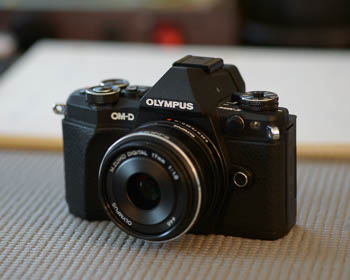 In late 2015 I found myself getting really tired of lugging around a big SLR and lens kit, and pulled the trigger on something I'd been considering for a long time: downsizing to a micro 4/3 kit. The time
seemed right with the introduction of the Olympus OM-D EM-5 Mark II and its high-resolution mode. It's true that 16 megapixel normal images didn't compare to the 36 megapixel beauties from the D800E, and the
EM-5's high-resolution mode wasn't the best in all situations (it definitely doesn't handle moving water well, one of my favorite subjects), but I accepted that compromise to get a complete kit including
f/2.8 midrange and telephoto zooms at well under 10 pounds, with coverage from 24 to 420 mm equivalent focal lengths. I didn't use my Nikon gear much after getting it.
In late 2015 I found myself getting really tired of lugging around a big SLR and lens kit, and pulled the trigger on something I'd been considering for a long time: downsizing to a micro 4/3 kit. The time
seemed right with the introduction of the Olympus OM-D EM-5 Mark II and its high-resolution mode. It's true that 16 megapixel normal images didn't compare to the 36 megapixel beauties from the D800E, and the
EM-5's high-resolution mode wasn't the best in all situations (it definitely doesn't handle moving water well, one of my favorite subjects), but I accepted that compromise to get a complete kit including
f/2.8 midrange and telephoto zooms at well under 10 pounds, with coverage from 24 to 420 mm equivalent focal lengths. I didn't use my Nikon gear much after getting it.
Micro 4/3 Lenses
I actually have no plans to get any more lenses for my mirrorless system! Can you believe it? Then again, most people probably stop before having seven of them.
- Olympus 12-40 f/2.8 PRO - So much smaller and lighter than the gigantic Nikon 24-70 f/2.8, just as well made, and just as good.
- Olympus 40-150 f/2.8 PRO - 80-300 mm equivalent zoom at f/2.8 in a relatively small precision crafted tool with great image quality? Yes indeed.
- Olympus 40-150 R - When the f/2.8 lens is too big, this diminutive equivalent of the 70-300 DSLR standby fits in a tiny camera bag.
- Olympus 17 f.1.8 - I wasn't completely happy with what I thought would be a fantastic little walkaround 35mm equivalent. It's decent enough.
- Olympus 60 f.2.8 macro - A really lightweight but well-made macro lens to cover my 1:1 needs.
- Olympus 14-42 II R - The tiny cheap midrange zoom that comes in handy as a super-light kit.
- Olympus MC-14 TC - Pushes the telephoto zoom 1.4x to 420 mm equivalent for all the focal length I need, short of Olympus' amazing 300 f/4.
- Rokinon 7.5 f/3.5 fisheye - Takes the place of my old Nikon 10.5 DX fisheye for interior shots, minus the autofocus (not a big loss on a fisheye) and a much lower price.
F-Mount Cameras
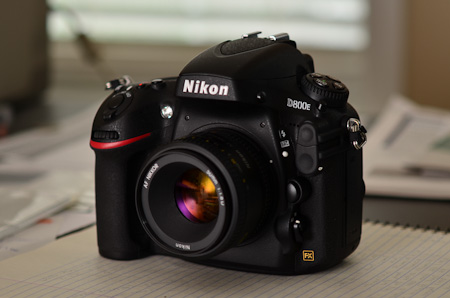 Behold, the Nikon D800E... at one time the creme de la creme of modern landscape DSLRs. I waited a long time to make the jump from crop sensor DX to full 35mm frame FX,
and I knew it was time when I saw this 36 megapixel, no-anti-alias-filter beauty announced in February 2012. It took me until July that year to actually find one,
no thanks to the long line at B&H, but my local Nikon supplier Cardinal Camera
came through in a pinch, right before my trip to Maine. The D800E was a great camera that just felt right and worked well,
a nice return to the smaller pro level cameras like the D200 and D300 after a brief interlude with the ergonomically inferior but optically superior D7000.
The D800E wasn't perfect -- mine may have had the infamous focus issues on the left side, although they weren't major, and also did the locking-up-on-playback every now and then that was quite annoying.
I didn't rely on either feature enough to worry about these issues too much. The D800E was also a big and somewhat heavy camera by itself, and especially combined with lenses that were good enough to get a lot out of its sensor.
I always use a Really Right Stuff or Kirk Photo L-bracket with my main DSLR (RRS for the D200, D300, and D7000, and Kirk for the D800E - because RRS didn't have any in stock at the time).
These days the D800E mostly just sits on a shelf, and gets pulled out to capture the really special shots locally; I don't really enjoy trekking around on woodsy hikes with 20 pounds
of gear on my back anymore.
Behold, the Nikon D800E... at one time the creme de la creme of modern landscape DSLRs. I waited a long time to make the jump from crop sensor DX to full 35mm frame FX,
and I knew it was time when I saw this 36 megapixel, no-anti-alias-filter beauty announced in February 2012. It took me until July that year to actually find one,
no thanks to the long line at B&H, but my local Nikon supplier Cardinal Camera
came through in a pinch, right before my trip to Maine. The D800E was a great camera that just felt right and worked well,
a nice return to the smaller pro level cameras like the D200 and D300 after a brief interlude with the ergonomically inferior but optically superior D7000.
The D800E wasn't perfect -- mine may have had the infamous focus issues on the left side, although they weren't major, and also did the locking-up-on-playback every now and then that was quite annoying.
I didn't rely on either feature enough to worry about these issues too much. The D800E was also a big and somewhat heavy camera by itself, and especially combined with lenses that were good enough to get a lot out of its sensor.
I always use a Really Right Stuff or Kirk Photo L-bracket with my main DSLR (RRS for the D200, D300, and D7000, and Kirk for the D800E - because RRS didn't have any in stock at the time).
These days the D800E mostly just sits on a shelf, and gets pulled out to capture the really special shots locally; I don't really enjoy trekking around on woodsy hikes with 20 pounds
of gear on my back anymore.
F-Mount Lenses
 Of course I've gone through a pile of lenses for Nikon cameras since I innocently got into this digital photography thing with the D70 kit, almost all Nikkors.
I realize I have too many lenses, but what can I say -- I like the gear! Most of my DX lenses are gone, now, as are some others I never used much.
Of course I've gone through a pile of lenses for Nikon cameras since I innocently got into this digital photography thing with the D70 kit, almost all Nikkors.
I realize I have too many lenses, but what can I say -- I like the gear! Most of my DX lenses are gone, now, as are some others I never used much.
- 24-70 f/2.8 - the premier normal zoom for FX cameras, although freaking huge for a midrange zoom, and still not quite as good as I'd like on the edges for landscapes.
- 35 f/1.8 DX - finally, a "normal" prime for DX. Amazingly sharp, just fix those CAs in post. I actually find it to be an excellent 42mm equivalent in 1.2 crop mode on my D800E for a tiny walkaround prime.
- 35 f/2 D - the older indoor and lowlight "normal" standard for DX sensor cameras, and of course moderate wide-angle on 35mm/FX cameras. I got rid of my original, but bought it again - it has character, but is better on DX.
- 50 f/1.8 D - the cheap quality standard, normal for FX sensor cameras but awkward on DX.
- 50 f/1.8 G - the slighty more expensive quality standard, normal for FX sensor cameras but awkward on DX. I bought into the hype, but it's not that much better than the D lens.
- 60 f/2.8 G - a macro legend, I got it for travel but wound up using it mostly at home. It's a heck of a lens, with wonderful rending for closeups.
- 70-200 f/2.8 VR I - the premier telephoto zoom at the time, big and heavy! The FX corners aren't great, but do I really want to shell out the money for something newer? No. It hardly ever gets used now.
- 70-200 f/4 VR - Nikon DID come out with an f/4 version! I agonized over my telephoto zoom choice, but decided go with this lighter option over the newer f/2.8 model (and saved $1000 in the process).
- 105 f/2.8 VR - another macro legend, but big and bulky. One of the best lenses I've seen in corner-to-corner sharpness, even for landscapes.
- 200 f/4 AI - a very small and lightweight manual-focus telephoto, which I wound up never using.
- 300 f/4 AF-S w/Kirk replacement collar - long and amazingly good, and not a bad macro lens.
- TC-14E II teleconverter - longer and almost as sharp, as necessary, with the 70-200's, 300, and 105.
- TC-17E II teleconverter - even longer and not as sharp, as necessary, with the 70-200's, 300, and 105. Mainly used with the 300 f/4 to get to 500 mm, although the quality kind of sucks.
I've also sold off a number of lenses and other stuff in the continuing evolution of my personal kit (see below). What I've found is that I really don't want to do ordinary photography, so my ordinary lenses tend towards the eBay scrapheap,
other than one or two lighter-weight convenience lenses.
I have a love/hate relationship with the gear - I love the results of the big pro lenses, but hate the weight, cost, and being conspicuous as a photographer. After I got the D800E the weight and size became just too much, although the results were great.
Micro 4/3 has been a nice compromise.
Other SLR Gear
 Of course everybody needs more than just a camera and a lens...
Of course everybody needs more than just a camera and a lens...
- Nikon SB-800 flash, which does pretty much everything. After owning it for about 7 years I discovered that it's actually useful to have it beep when it's a remote!
- Nikon SB-400 flash, which is a tiny travel unit that can do bounce flash and goes on many trips these days.
- Nikon R1 macro flash, rarely used, but invaluable when needed.
- Gitzo GT2540 4-section carbon fiber tripod with Markins M10 ballhead, which is my main tripod.
- Gitzo GT1550T 5-section carbin fiber tripod with Markins Q3T ballhead, which was my primary hiking and travel tripod.
- Manfrotto 3001N custom tripod, with 486 ballhead and short center column, for in the car for emergencies. When I say custom, I mean I took it apart, hacksawed the legs to half-height, and put it back together again.
- Manfrotto 3021BPRO tripod, with the dinky little Gitzo traveller ballhead on top (relegated to the closet).
- Manfrotto 676B monopod (little used now, good for killing spiders on the ceiling).
- Nikon 5T and 6T closeup diopters, which have become collector's items!
- Canon 500D closeup diopter, since Nikon hasn't had a 77mm diopter, although I haven't been thrilled with the results. Perfectionism is a bitch.
- Nikon CP 52mm, 67mm, and 77mm circular polarizers.
- B+W 77mm 0.9, 1.8, and 3.0 ND filters.
- Kenko Uniplus 25mm AF extension tube.
- Really Right Stuff MPR-CL and MPR-CL II Arca-Swiss rails, good for panoramas and macros and for better balance on lenses that lack tripod feet.
I would be remiss if I didn't mention another critical part of my gear: an Optech Utility Strap Sling, the best shoulder camera strap I've ever seen. It's quite awesome. I have a precious few Quantaray neoprene neck straps that are among the best I've ever seen.
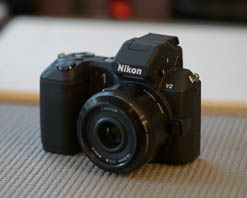 Nikon 1
Nikon 1
My "really small" kit at one time was a Nikon 1 V2 (which replaced the Nikon 1 V1 for which half of the sensor went bad), which got a pretty bad rap because of the puny little 1" sensor, but was actually a pretty cool little camera capable of decent output. In a lot of situations where the goal was just documentation
or snapshots, the D800E was overkill -- no question about it. It can produce spectacular results, but it's big and conspicuous, especially with the lenses that produce the aforesaid spectacular results. Sometimes I wanted to
go light and not worry about the big expensive gear; enter the V1/V2. I got the V1 with the kit 10-30 VR lens at the beginning of 2013 when Nikon was clearing out inventory and the kits were being cleared out at dramatically reduced prices, and added the V2 in late 2014 when they were similarly on sale.
It was surprisingly capable as a do-it-all camera, with image quality about equivalent to what I got years earlier out of the D200 and D300, enables extreme telephoto shots with longer SLR lenses (the equivalent of cropping the middle 14 megapixels
out of a 100 megapixel FX camera), and was just kind of fun to use because the camera and the gear that goes with it are so small. I can put the camera, flash, extra battery, and 3 lenses (10, 18.5, 30-110) in a tiny Lowepro Rezo 110 AW bag. Here's my full Nikon 1 kit:

- 10 f/2.8 CX - 27mm wide angle equivalent, this is the smallest CX lens.
- 10-30 f/3.5-5.6 CX VR - the standard kit lens sold with most Nikon 1 cameras; a pretty boring mid-range zoom that is capable but not great.
- 18.5 f/1.8 CX - a fast normal for the Nikon 1 system; a very good lens, actually.
- 30-110 f/3.8-5.6 CX VR - the 70-300 equivalent zoom for Nikon 1 cameras, capable of producing some really good output.
- SB-N5 flash - which is just about the cutest thing you've seen (for camera gear), a tiny version of a regular SLR flash unit that even has a tilting and rotating head for bounce flash! Very much needed, since the V1 has no built-in flash itself.
- FT-1 adapter, which allows me to mount any regular F-mount lens on the V1 (like, say, my 300 f/4 with 1.7 TC attached for an insane 1377mm equivalent field of view).
Other Cameras
 I've used a couple different underwater cameras over the years, first a fairly low-end Panasonic TS-12 (in late 2012) and later an Olympus Tough TG-4 in early 2016. The Panasonic was never that great,
but did the job until it got too much moisture inside and died rather abruptly. The Olympus has been much better, although both are still just very small sensor compact cameras. I discovered
underwater videos with the Olympus, and that's been a lot of fun while snorkeling. The TG-4 just keeps chugging along despite a great many snorkeling trips - they made it to last.
I've used a couple different underwater cameras over the years, first a fairly low-end Panasonic TS-12 (in late 2012) and later an Olympus Tough TG-4 in early 2016. The Panasonic was never that great,
but did the job until it got too much moisture inside and died rather abruptly. The Olympus has been much better, although both are still just very small sensor compact cameras. I discovered
underwater videos with the Olympus, and that's been a lot of fun while snorkeling. The TG-4 just keeps chugging along despite a great many snorkeling trips - they made it to last.
My compact camera of choice at one point was a Panasonic Lumix DMC-LX5. Compact cameras with large sensors were proliferating,
but none had the fast, high-quality Leica f/2 zoom lens of the LX5, and plus it was little bigger than my Nikon 50/1.8 lens! Of course, for a truly compact and convenient camera, it's hard to beat an iPhone - 3G, 5S, and SE have all produced great images in a pinch.
My wife has had a couple different compact cameras, first a Canon SD400 Digital Elph which died a watery death in the Baths in Virgin Gorda, and then a Canon SD-880 IS. They were small, and they shot JPEGs, and she liked them a lot. Now she just uses an iPhone 6S.
I have a Sony Mavica, one of the old sub-megapixel digital cameras with a built-in floppy disk drive. It was my Dad's first digital camera and has
since been passed down to me (this was before the D70, of course).
 My Dad's last film camera was a Nikon FM2, before he made the jump to digital with the Mavica and then (for good) with a Canon PowerShot G3. He recently replaced the G3 with a Panasonic LX7, after expressing a desire for something better and more compatible (and being impressed by the quality and convenience of my LX5).
I still marvel at how well the FM2 is built and how precise the mechanisms are, although the mirror slap kicks like a mule. It's got a few lenses and accessories as well:
My Dad's last film camera was a Nikon FM2, before he made the jump to digital with the Mavica and then (for good) with a Canon PowerShot G3. He recently replaced the G3 with a Panasonic LX7, after expressing a desire for something better and more compatible (and being impressed by the quality and convenience of my LX5).
I still marvel at how well the FM2 is built and how precise the mechanisms are, although the mirror slap kicks like a mule. It's got a few lenses and accessories as well:
- Nikkor 50 f/1.8 series E lens.
- Promaster 28 f/2.8 lens.
- Vivitar 70-150 f/3.8 zoom lens (probably a series E knockoff).
- Some brand X ancient flash unit: "Acme-Lite T/815 Thyristor". For real.
I even have an "ancient" (mid 80's) Polaroid Sun 600 instant camera, the kind that takes
10-shot cartridges and spits out a developed print immediately. Fixed focal
length and fixed focus, with a pop-up flash.
Former Cameras
The Nikon D7000 was a very decent camera in its own right, and when introduced combined the better build and features of the Dxxx series cameras with the smaller size and consumer features of the Dxx series.
In early 2011 I replaced my D300 with it mainly because of 1) improved resolution, although going from 12 to 16 megapixels wasn't that big a deal, 2) improved dynamic range, which really helped in post-processing shadow areas, and 3) a substantially improved live view mode for critical landscape and macro focusing.
Although smaller and lighter than the D300, the D7000 had some features that had formerly been absent from models like the D70, D80 and D90: mirror lock-up and a decently weather-proof build. It was a nice compromise of the latest developments in sensor technology with some of the more important pro-level features.
Unfortunately I was never happy with the autofocus on my D7000, and I went nuts trying to get it adjusted properly, even sending it back to Nikon (as far as I can tell, it came back the same as before). While the D7000's live view worked well, using it all the time to get critical focus right wasn't what I had in mind.
My Nikon D300 served me well for a few years, but was outpaced by advances in technology. When it came out, alongside Nikon's first FX camera, the D3, it impressed with its professional-level features and autofocus system. It replaced my D200 in early 2008, which D200 I wound up never using after the first night I had my D300!
I did bring both the D7000 and D300 to Alaska in July 2011, which was handy a few times when I kept the 300 f/4 on the D300 and switched shorter focal length lenses on the D7000, but sold the D300 in early 2012.
The Nikon D200 when it came out was a very welcome upgrade from the old D100, and was a dramatic upgrade from my then-current camera. I got the D200 in spring of 2006, replacing my first ever DSLR, a D70. I used the D70 exactly once after I got my D200, on a trip to Chicago. Looking back at some of my D200 pictures, it did have superb image quality at its optimal ISO setting, a creaminess that the D300 never quite matched.
My first DSLR was a Nikon D70, and I can blame it for getting me into this whole mess in the first place. For about six years after college I really didn't take any big trips, and then finally got back into travelling. I quickly realized that cheapo disposable cameras were not going to produce the types of images that I wanted to capture. I didn't agonize over the Canon/Nikon question -- Nikon's 18-70 kit lens felt a lot better, and that was that.
Going back even further, when I was a kid I had one of those sub-35mm film cameras, and I think for a little while even used an old Nikon SLR.
Former Lenses and Other Equipment
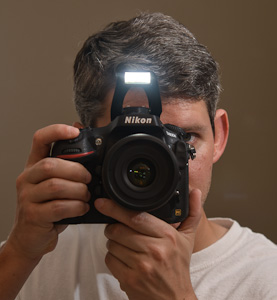 I've gotten rid of a fair amount of equipment as I've understood my needs better or upgraded various items, mostly via eBay:
I've gotten rid of a fair amount of equipment as I've understood my needs better or upgraded various items, mostly via eBay:
- 24-85 f/3.5-f/4.5 VR - a companion to my huge heavy 24-70, I used it when I want to carry a lighter kit with just the camera and a small zoom lens. D800E "light kit" being oxymoronic, I sold it.
- 10.5 f/2.8 DX fisheye - a very sharp lens, but certainly a specialty item. Great for interiors, combined with ImageTrends FishEye-Hemi. Replaced by my Rokinon for micro 4/3.
- Tokina 11-16 f/2.8 AT-X PRO DX - after I got rid of my 12-24 I began to miss a super-wide zoom, which is useful for interiors and dramatic landscapes. This seemed like the best choice. Although it sort of works at 16mm on full frame, I never really used it much.
- 70-300 f/4.5-f/5.6 VR - the latest and best version of a lightweight telephoto zoom at the time. Not that bad, and very good 70-200, but I just never really liked it. The image quality never quite gets the bite of the better lenses, and the handling is subpar.
- 17-55 f/2.8 DX - the original premier DX normal zoom, great at wider apertures and close up, requiring care and skill otherwise. I used this lens a ton for more than 6 years, but just didn't see any point in keeping it.
- 16-85 f/3.5-f/3.6 DX VR - the top "kit lens" for DX cameras. I loved it on the D300, but the 17-55 was clearly superior on the D7000's higher-resolution sensor. On an FX camera, it's of course useless.
- Nikon D7000 - this was a great DX camera in some ways, and very frustrating in others. High resolution and great dynamic range, much better than the D300, but autofocus that never worked that well. I also really, really missed the single-button 100% zoom review.
- Nikkor 85 f/3.5 DX VR - the perfect travel macro lens, as long as you are using a DX camera. Much better working distance than the 60/2.8. I just didn't use it much.
- Nikon DR-6 right-angle viewfinder, not really used once I got the D300. Sold in early 2012.
- Nikon D300 - The D300 was my upgrade from the D200, and a great camera -- but the image quality was outpaced by the D7000, with little loss in features, especially since I don't shoot sports. I sold it in early 2021.
- Nikkor 35 f/2 D lens - the older indoor and lowlight "normal" standard for DX sensor cameras, and of course moderate wide-angle on 35mm/FX cameras. Finally replaced by my 35/1.8 DX. I somewhat regret selling it - it had character.
- Nikkor 12-24 f/4 DX lens - wide and sharp. A good lens. I found myself just not using much since the range is covered by the 10.5 DX and the 17-55 DX and 16-85 VR zooms, and sold it in September 2009. I did regret selling it until I switched to FX.
- 18-200 VR lens - The controversial do-it-all lens, with which I had an "always about to sell it" relationship, until I finally did in late 2008. I replaced it with the 16-85 VR.
- Tamron 90 f/2.8 Di - A really good macro lens, which I sold in spring 2008. I thought for a long time before getting rid of this one, but for bugs I use my 105 VR, and for travel I thought I would use the AF-S 60 f/2.8. This is the only lens I really regret selling, and I might get another one.
- Nikon D200 - The D200 was my upgrade from the D70, and a very nice camera -- but it doesn't have the high ISO quality or live, big LCD of the D300. I sold it in spring 2008.
- Nikkor 70-300 f/4-5.6 ED lens - The standard consumer 300mm telephoto zoom at the time I got it, I sold it in November 2006, replaced by the 300/4.
- Nikkor 28 f/2.8 D lens - At one point I couldn't decide between the 28/2.8 and 35/2 for low-light and indoor photography; the 35/2 won, and I sold the 28/2.8 in November 2006.
- Manfrotto 3149 micrometric focusing rail with Arca-Swiss plate adapters, which I mostly used for panoramas.
- Nikon SC-29 remote flash cable - Which I really didn't need anymore with the R1 flash kit or the D200.
- Nikon D70 - The D70 was a very solid 6-megapixel DSLR from Nikon, positioned nicely between their entry-level and pro models. I sold it in November 2006. It started this whole mess.
- Sigma EM-140 DG macro flash - For a time this was the only iTTL macro flash compatible with Nikon cameras; then it was incompatible with the D200, and I replaced it with a Nikon R1 flash kit in August 2006.
- Nikkor 18-70 DX lens - This is the kit lens that came with the D70, and was replaced by the 18-200 VR.
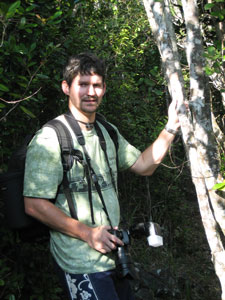

That's me many years ago taking a picture of who-knows-what in Sage Mountain National Park, Tortola, BVI, with a D70, 18-200, and SB-800. Why the diffusor? Beats me.
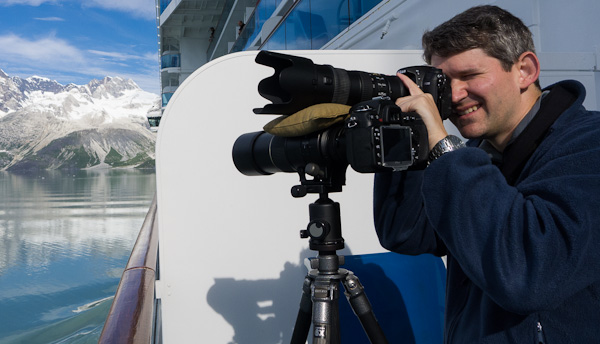
Yeah, that's more like it. Multi-tasking.
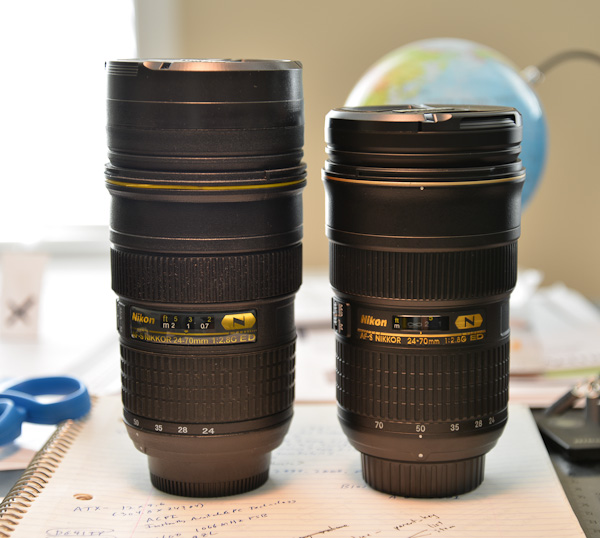
Which is the mug, and which is the lens?

